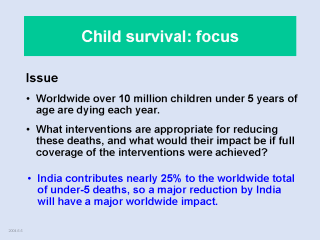| front |1 |2 |3 |4 |5 |6 |7 |8 |9 |10 |11 |12 |13 |14 |15 |16 |17 |18 |19 |20 |21 |22 |23 |24 |review |
 |
The
history of these child mortality estimates cover a little over a decade. 1989 marked a realization for UNICEF that relying on others for estimates of U5MR – the key indicator on children used by the agency – was problematic. Publication in The State of the World’s Children report of U5MR led to communications between the UN Population Division (UNPD) - the producer of the estimates used - and the Iran Ministry of Health, with UNICEF in the middle. Iran was not satisfied with the explanation given by UNPD, and both were unhappy with UNICEF’s role. This led to work in 1990-91, with UNPD and Johns Hopkins University, to develop a comprehensive database on U5MR data for more than 80 developing countries, including references, text and charts. The results were published in 1992. The 1992 report did not include trend estimates of U5MR based on the reported data, but reports in 1994 and 1996 by the World Bank and UNICEF demonstrated how this could be done. The estimation model was refined and new data and countries added for the “Green book” report of 1998 by UNICEF. The green book estimates were updated at the end-decade in order to report on progress towards the World Summit for Children goal on child mortality. Efforts at the start of the current decade to develop a single global set of country trend estimates for U5MR has since taken on a higher priority as a result of the adoption in 2001 by the UN General Assembly of the Millennium Development Goals (MDGs), with a specific goals on U5MR reduction. Building on the work already done, UNICEF, WHO and the World Bank are jointly pursuing this target of a single global set of U5MR trend estimates. |